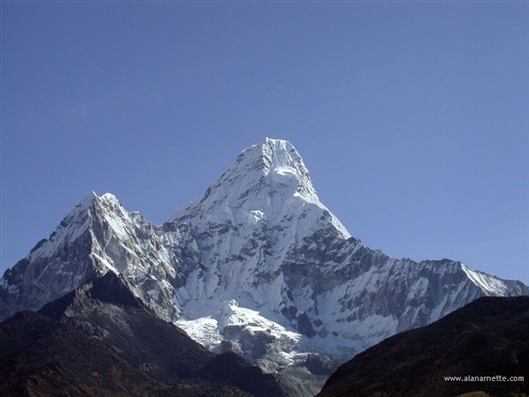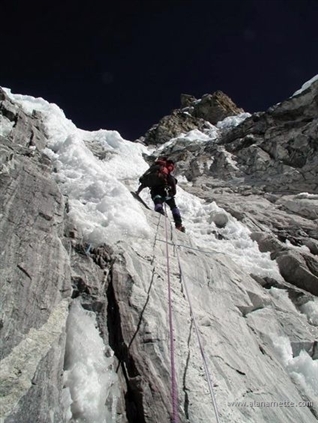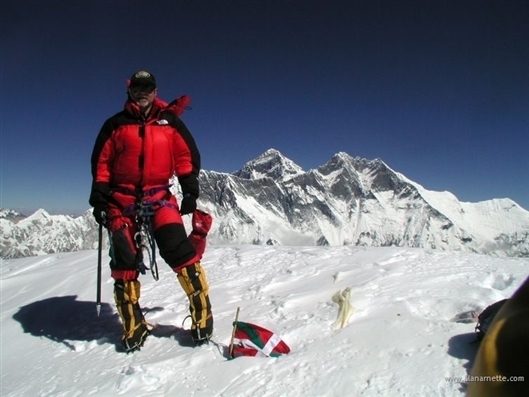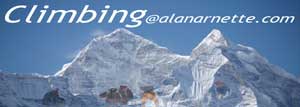 Ama Dablam is often called the Matterhorn of the Himalayas.
I admired it first while trekking in the Khumba - the area
leading up to Mt. Everest. It stands alone with a sharp top
and a huge snowcap. Sir Edmund Hillary once called it "unclimable".
I summited Ama Dablam at 10:30 on October 26, 2000. I went
with Adventure
Consultants out of New Zealand. I found the mountain a great challenge
with a nice mix of rock (up to 5.7), ice and snow. We had excellent
weather and a strong team resulting in summiting 4 days ahead
of schedule.
I
left Denver for Katmandu on October 9 and arrived in base camp about 10 days later after taking our time acclimatizing
during the trek in from Lukla. We established base camp in
a beautiful grassy meadow at the terminal moraine of a glacier
coming down from Ama Dablam. A stream provided fresh water.
We followed an aggressive acclimatization schedule on this
climb. There was one trip to Camp 1 followed by a day climb
to cache some gear below the Tower. After two nights at Camp 1, we
returned to BC for two days rest and then left for the summit. We
spent one night at each camp followed by one night at Camp 3 after
the summit due to one member not feeling well enough to go lower.
Camp 1 was at 18,500 and took about 3 hours to reach with
boulder scrambling required at the end. It is perched on
a rocky area just below a steep ridge. It was well protected but very
steep and dangerous. The primary technical climbing is between camps
1 and 2 and camps 2 and 3 with steep snow slopes from Camp 3 to the
summit.

The "tower" between 1 and 2 is the most challenging and
this year there was little ice or snow so it was nice rock. We pulled
our packs up the tower to allow us to climb with more freedom. With
our crampons still on, it was truly mixed climbing on the fixed ropes.
Our Sherpas fixed the ropes and hauled our packs up the
Tower.
Camp 2 sits atop a rock pillar. There is barely enough
room for two tents. There are extreme drop-offs on all sides. When
the wind blew, it was incredibly cold. We quickly ate before sunset
when it really got cold! The 70-degree couloir between camps 2 and
3 was fun and required attention to detail since there was extreme
exposure. It was mostly ice with a few spaces of bare rock. It was
not as difficult as the tower.
From here we followed narrow snow ridges to Camp 3 which
was on a relatively flat snow field just below the big snow mushroom
everyone sees from the Khumbu. We got a good nights sleep and
left for the summit about sunrise. Note, in 2006 an avalanche from the 'Dablam'
killed six clibmers at this same spot where the alos established
their Camp 3.
The summit climb was very cold. The route was mostly straight
up but not technically difficult. Similar to the other
climbing days, it was about a 5-hour climb up then about
4 down. We used the fixed ropes set by our Sherpas. The summit was
awesome on our clear, dry day. The wind was howling and the temps
cold but the views of Everest, Lhotse and Maklu were great. We stayed
at Camp 3 that night and returned to base camp the following day.
 I
trained seriously for the previous 6 months. In training
for Cho
Oyu, I mostly ran and got climbing experience in the Alps.
Generally speaking, my level of fitness was acceptable
for that climb but I often felt that I need more upper body strength.
So this time I have added weight training to my regiment and have
added over 15 pounds of muscle to my upper body. I think this helped
my overall strength since I had also been running a 5 mile course
at 5,000 feet 3 times a week for the the past several months. Finally,
I climbed the local Rocky Mountain peaks such as Longs and The
Grand Teton. I
trained seriously for the previous 6 months. In training
for Cho
Oyu, I mostly ran and got climbing experience in the Alps.
Generally speaking, my level of fitness was acceptable
for that climb but I often felt that I need more upper body strength.
So this time I have added weight training to my regiment and have
added over 15 pounds of muscle to my upper body. I think this helped
my overall strength since I had also been running a 5 mile course
at 5,000 feet 3 times a week for the the past several months. Finally,
I climbed the local Rocky Mountain peaks such as Longs and The
Grand Teton.
I believe my training helped during this climb since I
rarely felt leg weary, had headaches or other health difficulties.
Even though I lost 15 pounds (mostly muscle so I have to start over
again!) and got very minor frostbite on my finger tips, I never felt
better after a climb!
|


